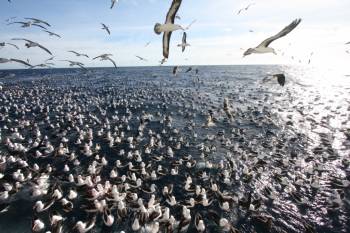Michelle Paleczny has been awarded a Master of Science degree this year by The University of British Columbia in Canada for her study of the relationship between global seabird decline and marine fisheries catch from 1950 to 2010.
The thesis abstract follows:
"Seabird populations worldwide are threatened by anthropogenic activities including hunting, introduced predators, habitat destruction, pollution, and fisheries, yet the cumulative effects of these threats on seabird populations is [sic] difficult to assess because seabird population studies are mainly limited to small temporal and spatial scales. The present study used global databases of seabird abundance, seabird distribution, and fisheries catch, to estimate global annual seabird population size, overall and by seabird family, 1950-2010; map observed global seabird population change within the same timeframe; and compare temporal and spatial patterns in seabird decline with fisheries, a major threat for which global temporally and spatially explicit data is [sic] available throughout the modern industrial era. The global seabird population was estimated to decline by 25% during the modern industrial era, from 1.023 billion individuals in 1950 to 0.768 billion individuals in 2010, and overall decline was observed in eleven of the fourteen seabird families. Maps of observed seabird population change indicated decline covering 90% of the world's marine surface area, and most severe in the southern temperate and tropical oceans. There was a significant positive relationship between annual seabird decline and annual forage fish catch (a metric of forage fish depletion), as well as between observed seabird decline per spatial cell and year of maximum primary production to support fisheries per marine spatial cell (a metric of the timing of peak ecological footprint of fisheries), both indicating that fisheries presence may play a role in shaping spatial and temporal patterns in global seabird population change. The present study identifies the temporally, taxonomically and spatially pervasive nature of global seabird decline during the modern industrial era and a potentially globally important role of fisheries in this global seabird decline, thus indicating the need for a large-scale and precautionary approach to seabird and marine ecosystem management."

Sharing the same resource? Black-browed Albatrosses gather behind a trawler
Photograph by Graham Robertson
Reference:
Paleczny, M. 2012. An analysis of temporal and spatial patterns in global seabird abundance during the modern industrial era, 1950-2010, and the relationship between global seabird decline and marine fisheries catch. MSc thesis, The University of British Columbia, Vancouver, Canada. 119 + x pp.
John Cooper, ACAP Information Officer, 20 December 2012

 Français
Français  English
English  Español
Español